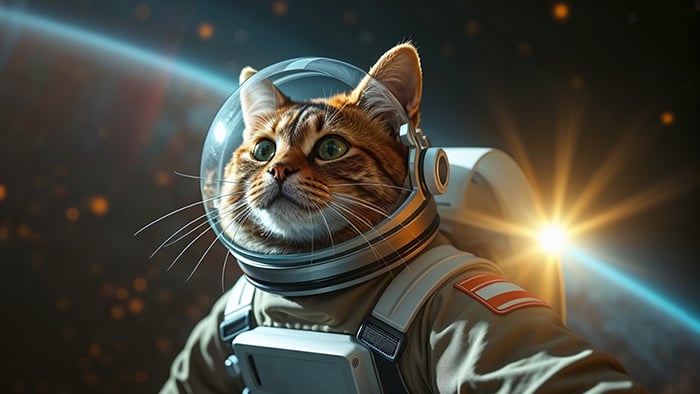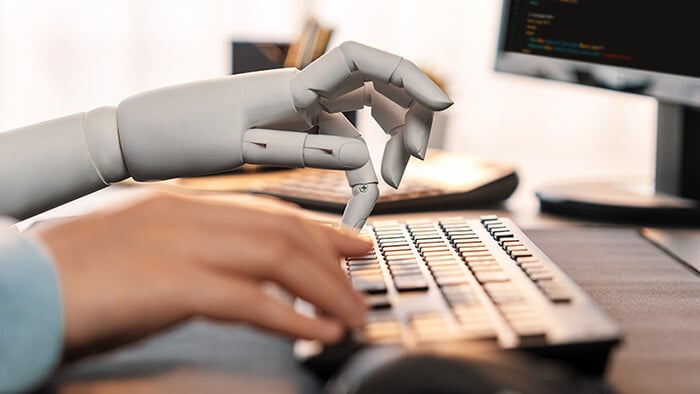Web 3.0 gets it. It understands what you mean and the context around how you navigate the web, and it can assemble information in a way similar to humans. Web 3.0 technologies can read between the lines to decipher the intent behind your online requests. According to Web 3.0’s supporters, those deeper insights will transform our digital lives.
But what is Web 3.0, exactly? Let's start at the beginning, with the launch of the World Wide Web, also known as Web 1.0.
Definition of Web 3.0, 2.0, and 1.0
Web 1.0 is the text-based or read-only web, Web 2.0 is the participatory or social web, and Web 3.0 is the open, decentralized, and immersive web.
Web 1.0 was the foundation of the web, and it consisted of static text and images. The next generation, Web 2.0, was defined by interaction and social media. Web 3.0 is the third iteration of the web, defined by open technologies like blockchain and immersive experiences like the metaverse.
Web 1.0
From the early days of static web pages (Web 1.0), to the two-way flow of information (Web 2.0), to the emerging decentralized open internet (Web 3.0), each successive generation of the web has built on top of the previous one, with engineers, designers, and users taking part in defining Web 1.0, 2.0, and 3.0.
The first iteration of the World Wide Web emerged in the late 1980s and early 1990s out of the need for better data sharing among the scientific community. The term “read-only web” was coined by Tim Berners-Lee, because while Web 1.0 made it much easier to exchange information, you couldn’t interact with websites, you could only read them.
The defining characteristic of Web 1.0 was static web pages with no interactivity. You went to a website and read information — the experience was passive. You can see the very first web page of Web 1.0 here.
Web 2.0
Web 2.0 emerged in the early 2000s, taking shape with the emergence of social media. Web 2.0 created spaces for sharing and interactivity, ushering in a new model far beyond the limitations of static web pages.
The defining difference between Web 1 vs Web 2 is the two-way flow of information. People started interacting with websites by sharing information or creating their own content. Think of platforms like Amazon, Google, Facebook, and Twitter, as well as online shopping sites, web forums, P2P gaming sites, and other social media.
What is Web 3.0, exactly?
Web 3.0, also known as Web3, is the third generation of the World Wide Web. Web 3.0 is meant to be decentralized, open to everyone (with a bottom-up design), and built on top of blockchain technologies and developments in the Semantic Web, which describes the web as a network of meaningfully linked data.
Web 3.0 is based on a specific set of principles, technical parameters, and values that distinguish it from earlier iterations of the World Wide Web: Web 2.0 and Web 1.0. Web 3.0 envisions a world without centralized companies, where people are in control of their own data and transactions are transparently recorded on blockchains, or databases searchable by anyone.
Web 2.0 vs Web 3.0
The main distinctions between Web 2.0 and Web 3.0 involve data storage, connectivity, currency, and decentralization. Web 2.0 is about creating content and interacting with websites. Web 3.0 means immersing yourself in the digital experience, and it involves concepts like individual control of personal data, cryptocurrency, and decentralized record keeping on the blockchain.
Whereas Web 2.0 operates on fiat money, Web 3.0 relies on cryptocurrencies and a decentralized finance (DeFi) model. This is part of the decentralization objective, which shifts control from centralized companies or governments to users or the collective. The premise of decentralization extends beyond currency, covering everything from apps to data.
Performance-wise, Web 3.0 will likely be slower than Web 2.0, at least at the beginning. That’s because transactions are processed over multiple servers (independently operated), instead of on one or a group of centralized servers.
It appears that we’re now in the process of moving from Web 2.0 to Web 3.0. In fact, some people say that we’re already living in Web 3.0.
Features of Web 3.0
Web 3.0 is explained best through its features, namely ubiquity, decentralization, artificial intelligence, and semantic web interactivity. Some Web 3.0 technologies have already emerged, such as the decentralized concept that underpins blockchain. Other Web 3.0 meanings are yet to be understood, let alone created.
Blockchain technology was created to facilitate cryptocurrency — the digital currencies that are decentralized (not controlled by central banks) and that are set to play a large role in Web 3.0. Known as Web 3.0 cryptos, these currencies — and other digital assets like NFTs — will be used to incentivize users and service providers, letting people transact directly with one another without having to go through third-parties like conventional banks.

Ubiquity
Ubiquity means appearing everywhere or being very common. The definition of ubiquity in terms of Web 3.0 refers to the idea that the internet should be accessible from anywhere, through any platform, on any device. Along with digital ubiquity comes the idea of equality. If Web 3.0 is ubiquitous, it means it is not limited. Web 3.0 is not meant for the few, it is meant for the many.
In Web 3.0, anyone can engage from anywhere, and they can contribute through open-source software. Web 2.0 touched on this with the advent of smartphones and greater internet access. If a user posts something on social media, it is essentially “everywhere.” With new gadgets and technology on the horizon, this real-time global connectivity will continue to gain momentum.
Decentralization
Web 3.0 envisions a truly decentralized internet, where connectivity is based completely on peer-to-peer network connections. This decentralized web will rely on blockchain to store data and maintain digital assets without being tracked.
Decentralized apps (Dapps) are also developed based on this concept. Instead of being maintained by a single server, decentralized apps are maintained by a network of computers. Some Dapps already exist using core Web 3.0 technologies.
Decentralized finance (DeFi) is central to DApps and shares many of cryptocurrency’s characteristics, but its applications are even wider. DeFi enables users to invest, save, and ultimately replace pre-existing financial institutions and their top-down modus operandi.
Artificial intelligence
Web 3.0 leans on artificial intelligence (AI) to develop computers that can understand the meaning or context of user requests and answer complex requests more quickly. The artificial intelligence of the Web 3.0 era goes beyond the interactivity of Web 2.0 and creates experiences for people that feel curated, seamless, and intuitive — a central aim behind the development of the metaverse.
Part of AI is machine learning and applying techniques like predictive analytics to outline relationships and patterns that help predict future outcomes and events. Whereas machine learning is passive, AI requires an agent to learn and interact with the environment.
From a user perspective, advancements in machine learning could lead to better customer support. Increasingly intelligent chatbots will be able to support multiple consumers at once, with far more accuracy than current standards. This advanced technology will also deliver ideal search results, identify fake news, and select high-quality content.

Semantic Web
Semantic means “relating to meaning in language or logic.” The Semantic Web improves the abilities of web technologies to generate, share, and connect content through search and analysis by understanding the meaning of language beyond simple keywords.
Websites of the 2.0 era have been created primarily for humans to read, with increased consideration for search engine understanding. Web 3.0 uses ideas of the Semantic Web as a springboard to take readability, creativity, and interactivity to another level.
Under Web 3.0, search engine, platform, and connectivity capabilities will skyrocket. Rather than discerning meaning from a series of ones and zeros, keywords, headers, links, and other metadata, computers will be able to understand context and identify your true needs and goals.
Is Web 3.0 the same as the Semantic Web?
No, web 3.0 is not the same as the Semantic Web. The two concepts are connected but not interchangeable. Web 3.0 is based on the notion of the Semantic Web, but it is not the Semantic Web itself.
The definition of the Semantic Web came about in 2006 from Tim Berners-Lee, computer scientist and inventor of the World Wide Web. His definition of the Semantic Web speaks of a future version of the web as an “integrated huge space of data” and “unbelievable data resource.”
Web 3.0 captures these ideas from the Semantic Web and evolves into something much bigger, integrating more diverse features such as AI, machine learning, decentralization, and peer-to-peer networks.
3D Graphics
Web 3.0 addresses the user experience on several levels, including the front-end experience, or how we take in what we see on our screens. 3D design is often used in websites and services in Web 3.0. The most common examples of it can be found in eCommerce, real estate, computer games, and virtual museum tours.

Examples of Web 3.0 applications
Web 3.0 applications incorporate AI and machine learning technology. Most of the Web 3.0 apps that are already live today involve cryptocurrency and finance. In the future, all types of apps will be created, making them smarter and more user-centric.
Siri is a good example of an app employing Web 3.0 technology. Apple’s AI assistant lets users control their surroundings and devices with voice commands. Another popular Web 3.0 app currently in use is the web browser Brave, which connects participants with Dapps, their crypto wallets, and other Web 3.0 technology.
Risks or downsides of Web 3.0
The lack of centralized gatekeepers in Web 3.0 could pose a significant risk to users. While Web 3.0’s decentralized ownership is seen to empower individuals, the lack of oversight can increase consumer risk, as was seen in the collapse of the major cryptocurrency exchange FTX.
Decentralization could make regulating Web 3.0 virtually impossible. And with the rapid increase of the amount of information stored on the web and additional interactions and transactions, unauthorized access to personal data could have devastating consequences.
There will also be new types of cyber attacks to contend with. Ice fishing and other FinTech hacks already exist, and novel cybersecurity threats will continue to emerge. More generally, widespread data manipulation could lead to disinformation. If all users are anonymous in the new world, this includes those with bad intentions. Holding people accountable for attacks and data manipulation will become even more complicated.
Aside from security threats, Web 3.0 consumes a lot of energy resources due to its reliance on blockchain technology. Mining cryptocurrency, DeFi transactions, and the decentralization of data require a huge amount of power to operate, which will put even more stress on global energy systems.
Examples of Web 3.0 in real life
Web 3.0 websites and Web 3.0 apps are already here. You've likely heard of them in the media, such as the costly examples of cryptojacking. Or, you may have already interacted with Web 3.0 applications, such as an Internet of Things appliance. Perhaps you’ve even explored the possibilities and meaning of the Metaverse. You may have been exposed to examples of Web 3.0 without even knowing it.

The unprecedented levels of interactivity will drive the need for broader awareness of the security risks of IoT. In mere decades, the world has moved from static Web 1.0 apps and websites to dynamic models and emerging Web 3.0 technology.
Web 3.0 exists in a technical manner, like blockchain, and a user experience manner, like a Web 3.0 app that can decipher your intent. Here are some examples of Web 3.0 that already exist:
-
Blockchain technology: a decentralized record of transactions that are stored on a huge number of computers across the internet. All transactions can be publicly viewed, rely on sophisticated encryption, and are permanent.
-
Cryptocurrency: a decentralized currency that isn't controlled by any government or central bank, using blockchain technology to record transactions. There are thousands of cryptocurrencies that currently exist, with Bitcoin being the most well-known.
-
NFT: a non-fungible token linked to a unique digital or physical asset that can't be replaced with something else. NFTs are not cryptocurrencies, which consist of fungible or tradable tokens. This creative example of Web3 technology is bound to evolve in the future.
-
Distributed computing or edge computing: this technology aims to deliver online data and services as close to where it's being requested or generated as possible. Edge computing leverages the processing power of many devices linked together, working as a kind of decentralized supercomputer. Decentralized computing is closely linked to the Internet of Things.
Get ironclad security for today and for the future
Regardless of whether you’re connected to Web 2.0 apps or already immersed in AI-powered Web 3.0 experiences, you need reliable cybersecurity to protect your personal data. Avast One is built on top of an award-winning anti-malware engine and includes built-in features like a high-speed VPN, optimization tools, and data breach monitoring. Secure your digital life today with Avast One.
FAQs
What’s the difference between Web 3.0 and Web3?
The terms Web 3.0 and Web3 are often used interchangeably. But Web 3.0 focuses on the Semantic Web, while Web3 refers to the idea of decentralization. Both concepts aim to give control back to users and offer an alternative vision of the web from the current one.
How does Web 3.0 benefit our lives?
As the third iteration of the web, Web 3.0 offers a range of benefits: It aims to make user experiences more seamless and tailored, on-screen visuals more appealing and advanced (3D graphics), and Web 3.0 technologies more secure.
What language will Web3 use?
Web3 will use numerous programming languages. Solidity is the most widely used language for blockchain programming, which is fundamental to Web3. Other important languages include C++, Java, Python, Rust, HTML, Vyper, Go (Golang), and C#.


















